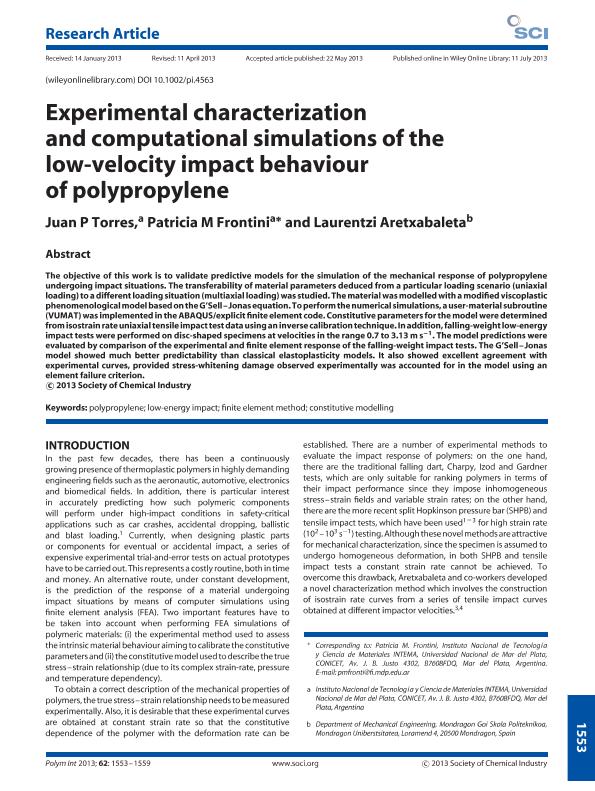Artículo
Experimental characterization and computational simulations of the low-velocity impact behaviour of polypropylene
Fecha de publicación:
11/07/2013
Editorial:
John Wiley & Sons Ltd
Revista:
Polymer International
ISSN:
0959-8103
Idioma:
Inglés
Tipo de recurso:
Artículo publicado
Clasificación temática:
Resumen
The objective of this work is to validate predictive models for the simulation of the mechanical response of polypropylene undergoing impact situations. The transferability of material parameters deduced from a particular loading scenario (uniaxial loading) to a different loading situation (multiaxial loading) was studied. The material was modelled with a modified viscoplastic phenomenological model based on the G'Sell–Jonas equation. To perform the numerical simulations, a user-material subroutine (VUMAT) was implemented in the ABAQUS/explicit finite element code. Constitutive parameters for the model were determined from isostrain rate uniaxial tensile impact test data using an inverse calibration technique. In addition, falling-weight low-energy impact tests were performed on disc-shaped specimens at velocities in the range 0.7 to 3.13 m s−1. The model predictions were evaluated by comparison of the experimental and finite element response of the falling-weight impact tests. The G'Sell–Jonas model showed much better predictability than classical elastoplasticity models. It also showed excellent agreement with experimental curves, provided stress-whitening damage observed experimentally was accounted for in the model using an element failure criterion.
Archivos asociados
Licencia
Identificadores
Colecciones
Articulos(CCT - MAR DEL PLATA)
Articulos de CTRO.CIENTIFICO TECNOL.CONICET - MAR DEL PLATA
Articulos de CTRO.CIENTIFICO TECNOL.CONICET - MAR DEL PLATA
Articulos(INTEMA)
Articulos de INST.DE INV.EN CIENCIA Y TECNOL.MATERIALES (I)
Articulos de INST.DE INV.EN CIENCIA Y TECNOL.MATERIALES (I)
Citación
Torres, Juan Pablo; Frontini, Patricia Maria; Aretxabaleta, Laurentzi; Experimental characterization and computational simulations of the low-velocity impact behaviour of polypropylene; John Wiley & Sons Ltd; Polymer International; 62; 11; 11-7-2013; 1553-1559
Compartir
Altmétricas




